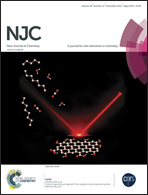Self-assembly of colloidal sulfur particles on a glass surface from evaporating sessile drops: influence of different salts†
Abstract
Evaporation of sessile droplets containing colloidal particles generates different self-assembled fractal patterns apart from the well-known “coffee-ring” effect, which have many applications. In this work, the formation of a self-assembled fractal pattern using colloidal sulfur particles (synthesized in situ by the reaction of sodium thiosulfate and different inorganic or organic acids) on the glass surface was investigated with the help of optical microscopy. The results indicate that the self-assembled structure is highly dependent on the type of acid (mono-, di-, or tri-) used for the reaction, which in turn forms different salts after completion of the reaction. Particles alone form the “coffee-ring” structure without forming any self-assembled fractal pattern, but the presence of salt in the reaction media helps to form different fractal patterns. Fractal patterns are, in fact, influenced by the crystal morphology of salts.


 Please wait while we load your content...
Please wait while we load your content...